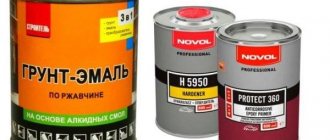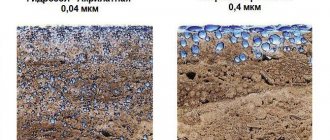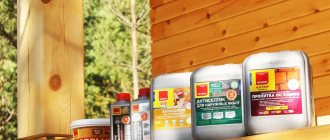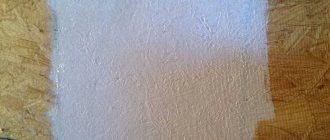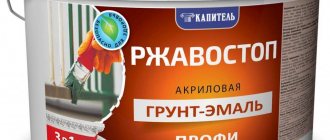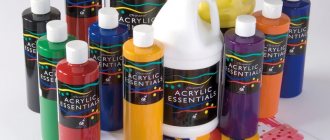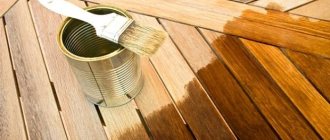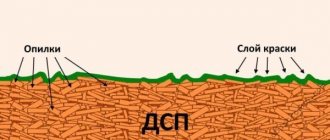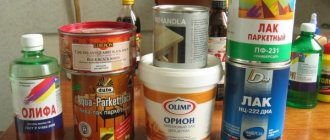Home page » Useful tips » How to paint metal
At first glance, the issue of painting metals does not pose any problems. Prepared surface, brush, paint, and your own hand. Take a brush in your hand, dip it into the paint and apply it carefully. But this is only at first glance. Already the first stage of selecting paint may puzzle you - the variety of paints on store shelves is very large. Metals are also not the same. What kind of paint do you need? Let's try to clarify this issue.
How to choose a primer for metal and how to apply it?
There are several factors to consider when choosing a primer:
Read also: Club work in elementary school
- what metal is processed;
- under what conditions it will be used (environmental aggressiveness, climatic conditions, mechanical loads);
- the type of substance that forms the film.
After choosing a primer, you can begin surface treatment. The first thing to do is check the existing paint layer. To do this, make two cuts, stick tape between them and sharply tear it off. If the paint comes off, it will have to be removed completely.
Next, you need to clean the surface from rust and other contaminants. After these procedures, you can begin to apply a thin layer of primer. Do this using a roller, brush and paint sprayer.
If the surface turns out to be glossy, then you need to clean it with fine-grained sandpaper for better adhesion to the paint. And only now can you begin to apply a layer of paint.
Technology of work execution
We prime metal surfaces
Later in the article we will tell you what technology should be used to prime metal, including removing rust and old coating from a car or surface.
Metal priming is done as follows:
- before painting and performing work on surface treatment of a car or product, it is necessary to clean off loose layers of steel that have been corroded using a spatula;
- the remnants of old paints and varnishes are removed in the same way, but only as a result of softening with a special remover or a hair dryer (if you use a remover, wrap the product in polyethylene, which will prevent the solution from evaporating);
- rust must be removed with a brush with metal bristles or specialized attachments for hand tools (you can also purchase a special rust converter that will transform it into a durable and insoluble coating);
- to perform subsequent work, the steel must be degreased with a rag or solvent;
- metal priming is carried out in 1-2 layers using a brush, rollers, or you can use an aerosol pneumatic spray gun;
Features of choice
First of all, anti-corrosion mixtures are selected based on the type and condition of the metal that needs to be treated. The main purpose of a primer when coating ferrous metals is to slow down corrosion. Iron, cast iron, black steel and alloys based on them used for outdoor work are very susceptible to corrosion due to interaction with a merciless environment. For these materials, if they have already begun to rust, a converter should be used as a priority. It will at least partially eliminate traces of corrosion. If the primer mixture is selected for external products made of non-ferrous metal or alloy, for example zinc, copper, brass, aluminum, then its primary function is to ensure maximum adhesion between the treated surface and other finishing material. For this purpose, you can choose compositions based on organic solvents, with a urethane base, and containing zinc. They can be used as a protective coating for galvanized iron or steel. Bronze, brass and copper are best protected with polyurethane or epoxy varnish. On sale you can find types of primers for metal that are applied to hide difficult to remove stains, for example, from grease, soot, etc. This step in the repair cannot be skipped if you do not want the stains to reappear over time or provoke peeling of the decorative finishing. After choosing a primer, you can begin to study the instructions for its external use.
IMPORTANT: 1. pay attention not only to the properties and types of primer, but also to the form of its release. To dilute powder bases and concentrates, it may be necessary to purchase a special solvent; 2. check the compatibility of the selected primer mixture with the planned decorative coating - they may be incompatible.
The feasibility of purchasing a primer
The primer for metal surfaces contains inhibitors. Their function in this case is the maximum delay or suppression of physical and chemical processes, i.e. development of corrosion. The influence of moisture and oxygen usually becomes the main reason, requiring advance protection of metal structures from imminent destruction. Any surface is susceptible to negative external influences, except when properly treated. Application of any type of primer guarantees the transformation of the emulsion composition into a colorless film that protects the product. This process must precede the finishing decorative treatment of the surface. Its main tasks are: · ensuring adhesion between external metal surfaces and finishing. Thanks to priming, the decorative material will not delaminate or crumble; · antiseptic treatment. The primer contains substances that inhibit fungus and mold; · corrosion protection. The primer prevents the appearance of rust; · reducing the consumption of decorative coatings. Metal primer for exterior work must be chosen wisely, which will reduce its consumption and obtain the expected high-quality result. It can safely be called an indispensable basis for decorative finishing, a budget-friendly way to protect metal from corrosion.
Advantages and disadvantages
Metal processing with a properly selected composition has a number of advantages:
- Saves paint and varnish material;
- Improves the quality of adhesion of paint and metal surfaces;
- Creates a protective layer against corrosion;
- Acrylic primers for metal are absolutely safe for humans and can be used indoors;
- Epoxy primers for metal have high strength properties.
Professionals say that the minimal costs associated with applying primer can delay repair work for a long time.
Characteristics of primer mixture for metal
The soil mixture is used both in large-scale production and at home. This is a solution used to combat corrosion phenomena and level out minor errors on the product. The film formed by the primer is resistant to temperature changes and high humidity.
There are several types of primers and each of them has its own consumption parameters per unit surface area.
Features of choosing soil for a fence
The primer will not only ensure an even and economical application of the decorative paint coating on the base, but also, if chosen correctly, will ensure a long service life of the fence and its presentable appearance. The choice of primer mixture depends on the characteristics of the material and its structure:
- Fence made of corrugated board. Beautiful, durable, easy to care for. In this case, only the pillars and load-bearing parts require additional processing. The profiled sheets themselves are coated with polymer decorative paint, which guarantees a long service life. After a few years, the coating may lose its original appearance, then the corrugated sheeting can be painted.
- A fence made using metal sheets. In this case, the pillars and surfaces are completely primed before painting. It is imperative to use mixtures with an anti-corrosion coating - they will provide reliable protection against corrosion and rust. By clicking on the link you can learn about the features of painting metal fences.
- Wooden picket fence is a natural, durable and beautiful material, but it requires special protection. Wood surfaces are primed with compounds containing antiseptics that protect against moisture, mildew and mold. Additionally, you can apply fire retardant impregnation, ensuring fireproof properties.
- Concrete fences are one of the most durable and popular. They are quickly erected, the material is inexpensive, but the porous structure of concrete easily absorbs water, is destroyed by atmospheric agents, and the gray color looks boring. Correctly executed priming and subsequent painting of a concrete fence can extend its life and turn it into a decorative element. Mineral-based soils are best suited for concrete - they fill the porous structure of the base well, significantly reduce the ability to absorb moisture, and ensure uniform application of the finishing coating.
- Brick fences, due to the variety of structure and color, are beautiful in themselves. They do not require additional decorative painting. But brick has strong moisture-absorbing properties and can quickly collapse under the influence of precipitation. For its long service life, it is better to use transparent primers that do not require subsequent application of paint.
Fence posts can be wooden or metal. For wooden posts, the same soil is used as for the main part of the fence, while metal posts require additional anti-corrosion protection.
For mixed surfaces, you can use universal compounds suitable for different types of material. Before processing, metal poles must be coated with an additional anti-corrosion coating to protect against rust.
Advantages of priming before painting
Priming the metal allows you to minimize damage from the influence of various factors and extend its service life. In addition, its use depends on:
- quality of application of decorative coating to the product;
- its durability;
- protection from the destructive effects of corrosion and rust;
- saving paint.
If you think about it, it is better to spend a little more time on current repairs before painting and postpone the prospect of subsequent repairs for a long time. Moreover, financial costs will also be significantly reduced, because soils are much cheaper.
The best primer manufacturers
One can hardly argue with the fact that the primer from a large, renowned manufacturer is of high quality. Buying a composition from a little-known company is always a risk: maybe you will be lucky and the material will meet your expectations, or maybe it will not have the declared properties or, even worse, it will ruin the surface. If you don’t want to risk the quality of the repair, it’s better to go straight to the store shelves with products from well-known primer manufacturers:
- Ceresit is a leader in the production of building mixtures; it has existed for more than 100 years and always relies on advanced technologies, quality control and expansion of the range. Due to the fact that today the company's factories are located in Russia, the cost of products has been reduced without loss of quality. The range includes a primer and a deep penetration primer-concentrate, a primer for absorbent mineral substrates, a primer for decorative plaster and a non-contact primer for treating smooth substrates;
- Knauf is a German company that has existed since the 30s and has been represented on the domestic market since 1993. They pay great attention to innovation, continuous improvement and implementation of comprehensive solutions for repair work. The range includes deep penetration primers, universal compounds for absorbent substrates, primers for cement plaster;
- Tikkurila is a Finnish company that has been in business since 1862. Factories are located in 7 countries around the world; they produce paints and other finishing and building materials. Primers are represented by acrylic compounds, universal, moisture-proofing and adhesive compounds;
- Caparol is a brand known throughout the world. The company's history began back in 1885 in Germany, and today its products are used in hundreds of countries. It produces primers for interior and exterior use, incl. frost-resistant and antiseptic compounds;
- Weber is a company that is now part of the Saint-Gobain group and produces building mixtures under the Vetonit brand. The assortment includes primers for exterior and interior use; if necessary, they can be tinted;
- IVSIL is a domestic company operating since 1997, has constantly developed and today has grown into a large manufacturer of building mixtures. Produces a universal primer and a deep penetration primer;
- "Prospectors" is a domestic company founded in 1992. At first, only putties were produced here, then they began to establish the production of other mortars and mixtures, improved recipes, purchased raw materials from leading manufacturers, introduced innovations, and now it is one of the largest Russian manufacturers of primers. The range includes universal compositions, primers for highly absorbent surfaces, and concrete-contact primers.
Where can I buy the right primer for metal?
The answer to this question is a continuation of the previous topic. You can now easily find out how much a particular metal primer costs and what its rating is from the Internet. Just scroll through the pages of online stores and study the current prices for the products you need. To compare the results, all numbers must be reduced to a common denominator. That is, the comparison should not include the price per package, but the price per 1 kg or price per liter.
Attention! Since Russia is one of those countries where there are still a lot of counterfeit goods, including metal primers, you should only buy the latter in reliable stores.
A particularly reliable way to purchase is through the website of the manufacturing company. On our website you can find out all the technical details of the product, as well as the real cost - what retail and wholesale will cost. All prices without intermediary surcharges. The company works using the most modern materials from the best suppliers, as well as advanced technologies, including organizational ones, such as contract manufacturing. GOODHIM specialists are always ready to dialogue with clients and can choose the most advantageous offer for each.
Options for primer mixtures for metal
There are several common processing solutions that help facilitate final processing of the product and improve its performance:
- Alkyd primers are a very common option and are used most often. It consists of an alkyd composition in the base, with the use of various stabilizing substances and additives. The color of the coating is gray or brown. It is highly durable and dries quickly. Also contains: red lead, whitewash and other components. Compatible with almost any type of final coating.
- Products consisting mostly of orthophosphoric acid. It is used for surface types that are already slightly affected by corrosion. The solution helps restore the material and free it from rust. Phosphorus primers stop all oxidative processes and, as a result, strengthen the product. When using such products, it is imperative to remove rust from the surface being treated.
- Acrylic, water-dispersed options are used indoors, increase adhesion, and level the surface. This composition dries quickly and is suitable for coating iron surfaces and alloys of non-ferrous metals.
- Inhibiting primer. This composition does not form a general film over the product, but penetrates directly into the surface at the molecular level. As a result, some properties of the material change, it becomes denser and harder. When processed, they combine the properties of the primer mixture itself and the enameled surface. Every day such coatings for various metal surfaces are becoming more and more in demand.
- Protective. This product contains magnesium and zinc. The higher the content of powders in this mixture, the higher quality it is considered. Particularly popular are compounds that contain red lead. Thanks to these components, the metal surface hardens and even the smallest scratches do not form on it. Ideal for those structures and products that have frequent contact with fresh and sea water.
- Converter. A variant of a mixture that is mixed with a corrosive coating. As a result, the structure of these stains becomes more porous and can be easily removed from the metal surface. Therefore, at the beginning of work on such material, it is not necessary to clean off rusty areas from the surface. Therefore, transformative compounds are an option for the lazy.
- Insulating mixtures. In this version, the base is a neutral pigment. But the primer itself has a short shelf life.
Each subtype of soil mixture has its own characteristics, which should be clarified when selecting. It must be suitable for the type of metal that is supposed to be processed.
The optimal characteristics for a standard metal primer are:
- semi-gloss or matte type of film;
- the period during which the mixture dries should be no more than 12 hours;
- elasticity parameters of the finished film without taking into account bending - no more than 1;
- conditional viscosity parameters more than 45.
This primer will significantly increase the service life of the metal surface and paintwork.
Operating principle
To achieve a good effect from applying primer, it is important to choose the mixture correctly. Primers can be intended for non-ferrous and ferrous metals.
For black steel, iron, alloys and cast iron, it is worth using substances that help slow down corrosion processes. These alloys suffer greatly from the effects of corrosion. In addition, primer for metal helps to achieve higher adhesion for further painting.
For non-ferrous metals and alloys - zinc, aluminum, brass - applying primer helps achieve adhesion of the finish and base. These compounds should be combined with galvanized iron and steel. Also, compositions based on organic solvents are excellent for galvanized metal. Black metal surfaces that contain active traces of rust should be coated with converters.
With the help of liquid it is possible to transform corrosion into a durable film. It helps restore damage to the metal surface. Working with such compositions does not require significant preliminary cleansing. To achieve noticeable results, it is worth getting rid of surface contaminants.
Among the primers for metal, it is also worth highlighting a special construction mixture. This substance helps remove stains from surfaces that do not absorb moisture. Such substances block contaminants - in particular, fat and soot.
The soil for outdoor work should be chosen taking into account the climate of individual regions. If a substance is required for interior finishing, it is recommended to take into account the operating conditions and toxicity parameters of the specific product.
See also
Types and composition of neon paints and how to make them yourself at home
So, the use of special primers for metal surfaces helps achieve the following results:
- Protect the surface from the effects of corrosion. This is especially true for ferrous metals. These include steel, cast iron and other alloys containing iron.
- Improve adhesion. Any enamel or varnish will adhere much better to a primer. The coating will not crumble under the influence of negative climatic factors. This is very important for steel and galvanized iron. This also applies to non-ferrous metals and alloys, which are difficult to rust, but even more difficult to coat with something without the use of primer.
- Mask small defects, that is, smooth the surface. This helps to significantly save finishing enamels and varnishes, the cost of which usually exceeds the primer.
- Strengthen mechanical strength.
If you choose the right soil, taking into account all the features of external or internal work, you will be able to significantly increase the service life of the coating and improve the aesthetic parameters of building structures, cars, plumbing fixtures and other metal objects.
Rules for priming metal for painting
When priming metal structures, a number of rules and recommendations must be followed.
Calculation of material consumption
The required amount of materials is usually indicated on the packaging. Specific parameters are influenced by the composition, temperature and humidity, and characteristics of the surface being treated.
Surface preparation and preparation of working solution
At the surface preparation stage, it is necessary to clean it. To do this, dust particles and contaminants are removed from the metal. You also need to get rid of rust-damaged areas. This makes it possible to apply primer and paint more evenly.
Applying primer
Before using the soil, you must read the instructions. Application may require a roller, brush or spray. Layers need to be made as thin as possible. It is better to increase their number. The primer must be completely dry before applying the finish. If required, the coating can be made rough. To do this, it is recommended to use sandpaper.
Layer drying time
The following factors influence the drying time of the primer:
- Surface quality. On dry and porous surfaces, the material dries much faster. To speed up the process, you can degrease the soil before using it.
- Temperature and humidity. The optimal parameters include +15-20 degrees and 60-80%. Before applying primer, the room must be ventilated. After using the substance, this should not be done, as the surface may become cracked.
- Layer thickness. The more layers are applied, the longer the primer takes to dry.
- Composition of the mixture. Materials that contain solid components or easily volatile solvents dry much faster.
Alkyd types of primer are considered the best option for treating metal surfaces. They take 10-12 hours to dry.
Preparation for priming
Before starting to process metal surfaces, they must be cleaned. Dust, dirt, old paint, varnish or enamel - all this can be removed using convenient means at hand (metal brushes, abrasive brushes, spatula, etc.). If the metal structure being treated has already undergone corrosion, then the primer can be applied only after using the converter. Use paint softener to remove dried paint. It also contains anti-corrosion additives. After complete cleaning, the outer coating should be thoroughly washed and sanded. Large metal structures are polished with special machines. For small exterior work, use sandpaper of a suitable grain size and lint-free cotton cloth. The next step is degreasing the surface. It is carried out immediately before the priming process. The most suitable for this purpose are: White spirit, gasoline and other mixtures of similar composition. Degreasing is necessary for uniform coating of the metal and its maximum adhesion to the anti-corrosion mixture. If the surface has few defects with a greasy base, then you can limit yourself to local processing.
Priming process
In order to take into account all the nuances and do high-quality work, you need to master priming “in theory”: application, characteristics and material consumption. You need to prepare convenient tools, take care of your own safety measures, and become familiar with how to store the primer if you don’t use all of it.
Available means
The choice of tool for external application of primer depends on the form of release of the material, the relief of the metal coating, and its area. Possible options:
- · the roller is convenient to use for processing large and smooth products. It is easy for them to distribute the mixture of any consistency. The roller ensures economical application of the material;
- · It is advisable to purchase a brush if you need to prime a small external metal structure or treat hard-to-reach places. In other cases, its use will lead to increased material consumption and time;
- · spray guns come in different sizes and power, so they can be used to apply primer to any surface. They allow this type of external work to be carried out quickly, economically and with the highest quality.
A building materials store may offer you a primer solution in an aerosol can. This is a convenient option, but due to its low capacity it is unprofitable when it comes to covering a large metal structure. Regardless of the type of future work (external or internal), do not forget to purchase gloves, goggles and a respirator.
Applying primer
Correct distribution of the anti-corrosion mixture over the outer surface of the metal structure will avoid its overuse and obtain the required uniform protective layer of primer. Follow these guidelines:
- work at temperatures from -10°С to +27°С;
- Apply the solution in a thin layer. This facilitates its penetration into all irregularities and microcracks, rapid drying, and the creation of a durable film;
- Applying each subsequent layer is possible only after the previous one has completely dried. The number of layers depends on the location of the external metal structure, its operating conditions (the more severe they are, the more material will be needed);
- the final decorative finishing should be carried out within the next few days after the primer has dried. Otherwise, the outer surface of the product will begin to become covered with dust, which will significantly reduce the adhesion of the finishing material to the coating.
Remember: the importance of taking breaks during priming is solely due to the need for the protective material to dry completely. It must be purchased in advance in the required volume to avoid downtime. The information on its packaging will help you calculate the required amount of the selected primer: “Consumption per 1 m2.” By the way, if a frost-resistant composition is used, then its application should be preceded by the distribution of a moisture-repellent primer mixture.
Storage of soil mixture
Any type of paint or primer should be stored in a container with a tightly closed lid. They should not be left near heating systems, electrical appliances, or fire sources. It is recommended to store in places where direct sunlight does not penetrate, the temperature does not exceed average values, and ventilation air flows are provided. The finished mixture will gradually thicken in the container - it can be diluted with a solvent if necessary.
